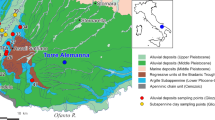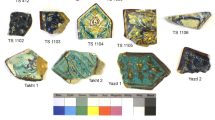Abstract
Thirteen Teotihuacan-style ornaments of an incense burner were studied. Ceramic pastes, pigments and mica were analyzed by neutron activation, X-ray diffraction and scanning electron microscopy. Elemental (Sc, Cr, Fe, Co, Rb, Cs, La, Ce, Nd, Sm, Eu, Tb, Yb, Lu, Hf, Th and U) and statistical analyses of ceramic-body data showed that these pieces were made from the same raw material, which is chemically different from the fine orange ceramic of Teotihuacan. Montmorillonite and the classical components of sand were the minerals identified in the ceramic pastes. The white pigment contained calcium, titanium and aluminium, the yellow pigment was ocher, and the red pigment was a mixture of red ocher and cinnabar, the binder of the pigments being clay. Exoskeletons of diatoms and locust ootecs were found in the pigments. Mica was identified as biotite, identical with that coming from Monte Alban Oaxaca. We wish to undertake a historical reconstrution of these ornaments based on archaeometric and literature data.





Similar content being viewed by others
References
Barba de Piña-Chan B (1988) Eduardo Luis Pareyon Moreno. La Antropología en México, Panorama Histórico. Los Protagonistas. Col. Biblioteca del INAH, Mexico
Hernández Pons E (2001) Eduardo Pareyón Moreno. Suplemento, Apuntes Biográficos. Revista Diario de Campo No 30-Marzo. CNA-CONACULTA-INAH. Mexico
López Palacios JA, Villa T (2003) Proyecto Arqueológico Colección Pareyón. CNCPC-INAH, México, pp 1–140
Munera LC (1985) Un taller de cerámica ritual en La Ciudadela. Tesis de licenciatura en arqueología. ENAH. Mexico, 1–136
Sejourné L (1959) El culto de Xochipilli y los braseros teotihuacanos. El México antiguo. Revista internacional de arqueología, folklore, historia, historia antigua y lingüística mexicanas. Tomo IX. Editado por la Sociedad Alemana Mexicanista, México, pp 111–124
Gamio M (1979) La población del valle de Teotihuacan. Edición Facsimilar. Clásicos de la antropología mexicana. Colección INI. No. 8-II. Volúmenes 2 y 3.INI. México
García Chávez RE (1991) Desarrollo cultural en Azcapotzalco y el área suroccidental de la Cuenca México, desde el Preclásico Medio hasta el Epiclásico. Tesis de licenciatura en arqueología. ENAH. Mexico, 244
Sejourné L (1956) Informe sobre el material exhumado en Ahuizotla, Azcapotzalco. Revista mexicana de estudios antropológicos. Editado por la Sociedad Mexicana de Antropología. Tomo 14, 2ª parte.1956-1957. Mexico, 33–35
Piña Chan R (1960) Mesoamérica, Ensayo Histórico Cultural. Memorias VI. INAH-SEP, Mexico, pp 66–93
Chávez Torres RL (1992) Una zona de entierros humanos del posclásico en Azcapotzalco, D.F. Tesis de licenciatura en arqueología. ENAH, Mexico
Jiménez-Reyes M, Tenorio D, Esparza-López JR, Cruz-Jiménez RL, Mandujano C, Elizalde S (2001) J Radioanal Nuclear Chem 250:465
Bayliss P, Erd DC, Mrose ME, Sabina AP, Smith KD (1986) Mineral powder diffraction file date book. JCPDS International Centre for Diffraction Data, Swarthmore Pennsylvania
Neff H (2008) Gauss routines for statistical analogies y multivariate archaeometric data. MURR (http://archaeometry.missouri.edu)
Abascal R (1974) Análisis por activación de neutrones: Una aportación para la arqueología moderna. Tesis de maestría. ENAH, Mexico
Tenorio D, Almazán-Torres MG, Monroy-Guzmán F, Rodríguez-García NL, Longoria LC (2005) J Radioanal Nucl Chem 266:471
Aburto S, Urrutia J, Manzanilla L, Barba L, Jiménez M (1991) Estudio interdisciplinario de las arcillas de Teotihuacan y del centro de Veracruz. Antropología y Técnica. 4. IIA-UNAM, México, pp 7–55
Castillo Mangas MT (1987) Informe del análisis cerámico de San Miguel Amantla, Azcapotzalco, D. F. Archivo Técnico-INAH. México, 1–59
Gazzola J (2000) Los usos del cinabrio en Teotihuacan. Tesis Doctoral. Universidad Pantheon-Sorbonne, Paris I. Francia
Rosales de la Rosa EA (2004) Manufactura y distribución de la mica en Teotihuacan. Tesis de licenciatura en arqueología. ENAH-INAH, Mexico
Ville CA (1988) Biología. 7ª edición Nueva Editorial Interamericana, Mexico, 148–153 and 267
Sotomayor-Castañeda A (1968) Estudio petrográfico del área de San Juan Teotihuacan, Edo. Mexico. Materiales para la arqueología de Teotihuacan.. José Luis Lorenzo, Ed. INAH. México, 17 and 39–50
Ramos-Elorduy J, Pino JM (1989) Los insectos comestibles en el México antiguo. AGT Ed, Mexico
Acknowledgments
The authors are grateful to M. Espinoza and I. Martinez (ININ) for XRD analyses, to J.A. Alba (INAH) for SEM analyses, to J. Muñoz Lujano (ININ) for his technical assistance and to ININ for a grant to one of us (RLV).
Author information
Authors and Affiliations
Corresponding author
Rights and permissions
About this article
Cite this article
López-Valenzuela, R., López-Palacios, J.A., Jiménez-Reyes, M. et al. Characterization of ceramic ornaments of a theatre-like incense burner. J Radioanal Nucl Chem 283, 675–681 (2010). https://doi.org/10.1007/s10967-009-0439-2
Received:
Published:
Issue Date:
DOI: https://doi.org/10.1007/s10967-009-0439-2




